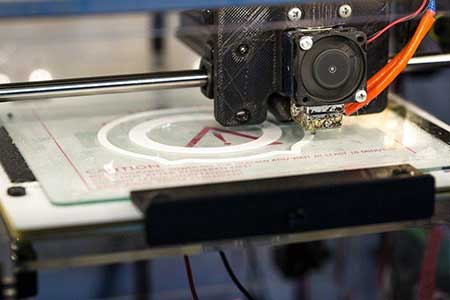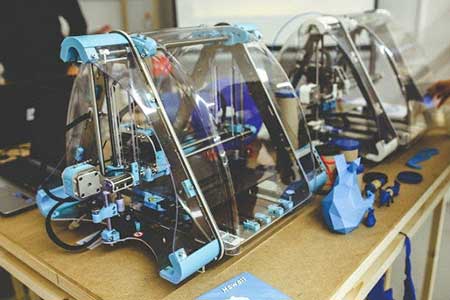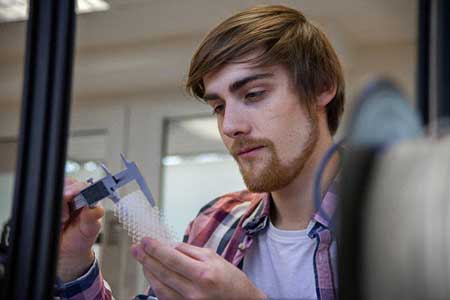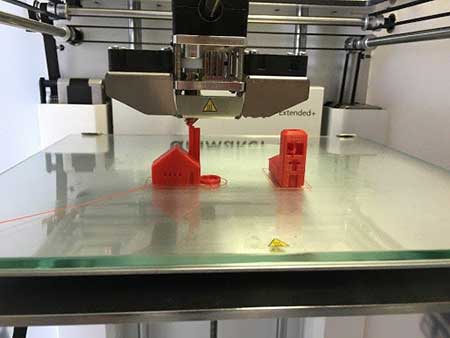
3D Prototyping, also known as Rapid prototyping, is the process of creating a design by manufacturing physical prototypes and testing them to make improvements to a design until it is finalized.
To do this 3D printers form shapes by adding layers of heated material on top of each other until they form a desired shape. The technology is continuing to develop and the opportunities for the future it provides are exciting and endless.
Before 3D printers were developed, prototyping was limited to injection molding and CNC machining. This can take weeks or sometimes months to develop each round of prototypes, depending on the complexity of the project. It generally is also more expensive as well.
What Products CAN be 3D Printed?
 3D printing excels when used to make plastic prototypes. Many metals such as titanium, tool steel, stainless steel, and nickel alloys can be 3D printed. Other materials such as Ceramics, glass, carbon fiber, and electronic circuit boards can also be 3D printed.
3D printing excels when used to make plastic prototypes. Many metals such as titanium, tool steel, stainless steel, and nickel alloys can be 3D printed. Other materials such as Ceramics, glass, carbon fiber, and electronic circuit boards can also be 3D printed.
People are even figuring out how to 3D print organs using bio-material that can simulate the function of the organ. You can see it in action here.
Newly developed 3D printers can print the chassis of a car, though these printers are astronomically expensive and the technology is still being improved upon.
What Products CAN’T be 3D Printed?
 Any material that can’t be melted and extruded from a nozzle can’t be 3D printed. Materials such as wood, cloth, paper, and rocks can’t be used to make 3D printed prototypes because they would burn away before they can be melted and extruded through a nozzle.
Any material that can’t be melted and extruded from a nozzle can’t be 3D printed. Materials such as wood, cloth, paper, and rocks can’t be used to make 3D printed prototypes because they would burn away before they can be melted and extruded through a nozzle.
Some odd shapes have a hard time of getting 3D printed. Although most shapes can be 3D printed, there
Shapes that don’t have much contact with the bed of the printer are difficult to print because with their small base, they are very likely to pop off the bed of the printer. Something like a sphere doesn’t have much surface area at its base to support the process of the 3D printing.
Shapes that are supposed to have edges with very fine details such as a feather or a sharp edge like a knife are also difficult to 3D print as well. This is due to the geometry of the path the nozzle can take as well as the nature of extruding material from a nozzle.
Parts with large overhangs are also extremely difficult to 3D print, and sometimes they are impossible to do so. When a shape is hanging too far from its previous layer, it tends to break off before the layer can form and solidify.
Why to Use 3D Printed Prototypes?
 3D Printing is ideal for most prototypes because it saves you time and money from more traditional prototyping methods. Rather than have to make, rework, and possibly remake molds or other tooling, you can quickly get 3D printed prototypes made and remade, fast-tracking the product development process and saving you time and money.
3D Printing is ideal for most prototypes because it saves you time and money from more traditional prototyping methods. Rather than have to make, rework, and possibly remake molds or other tooling, you can quickly get 3D printed prototypes made and remade, fast-tracking the product development process and saving you time and money.
Traditional methods of prototyping such as CNC machining or injection molding require much more in material costs and hours of labor, which can quickly become costly.
When NOT to 3D Print Your Prototypes
You don’t want to 3D print your prototypes if the finish or structural integrity and durability of the prototype is crucial.
3D printers lay out each layer of material in a lattice formation, which means that 3D parts are not solid material, and can lead to them breaking depending on the material used.
If the tests you perform on the prototype require testing the strength of the part, or you need to showcase parts to potential customers or investors, then it it’s probably better to use CNC machining to make your prototype.
You also don’t need to 3D print parts for stock items. Most of the time, it is cheaper to simply buy a stock item for your prototype than it is to replicate it.
If you have more questions on prototyping or would like to get a quote for a prototype on one of your products, feel free to contact us! Our team would be happy to assist you. We have access to 3D printing, CNC machining and injection molding for your prototype requirements.
